The Adventures of Sherlock Holmes (1939) and A Study in Terror (1965)
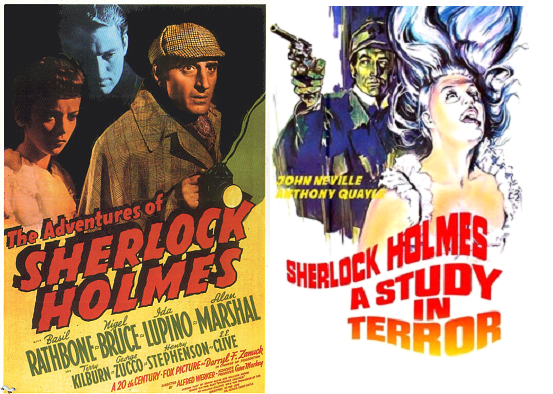
Toronto Film Society presented The Adventures of Sherlock Holmes (1939) on Sunday, September 25, 1988 in a double bill with A Study in Terror (1965) as part of the Season 41 Sunday Afternoon Film Buffs Series “B”, Programme 1.
The Adventures of Sherlock Holmes (1939)
Production Company: 20th Century Fox. Producer: Gene Markey. Director: Alfred Werker. Screenplay: Edwin Blum, William Drake, based on a play by William Gillette. Music Director: Cyril J. Mockridge. Cinematographer: Leon Shamroy. Editor: Robert Bischoff.
Cast: Basil Rathbone (Sherlock Holmes), Nigel Bruce (Dr. Watson), Ida Lupino (Ann Brandon), Alan Marshal (Jerold Hunter), Terry Kilburn (Billy), George Zucco (Prof. Moriarty), Henry Stephenson (Sir Ronald Ramsgate), E.E. Clive (Inspector Bristol), May Beatty (Mrs. Jamison), Peter Willes (Lloyd Brandon), Mary Gordon (Mrs. Hudson), Holmes Herbert (Justice), George Regas (Mateo), Lady Conynham (Mary Forbes), Frank Dawson (Dawes, the butler), Arthur Hohl (Bassick).
A Study in Terror (1965)
Production Company: Columbia. Producer: Henry E. Lester. Executive Producer: Herman Cohen. Director: James Hill. Screenplay and Original Story: Donald and Derek Ford, based on the characters created by Sir Arthur Conan Doyle.
Cast: John Neville (Sherlock Holmes), Donald Huston (Dr. Watson), John Fraser (Lord Carfax), Anthony Quayle (Dr. Murray), Robert Morley (Mycroft Holmes), Barbara Windsor (Annie Chapman), Adrienne Corri (Angela), Frank Finlay (Inspector Lestrade), Judi Dench (Sally), Cecil Parker (Prime Minister), Georgia Brown (Singer), Barry Jones (Duke of Shires), Kay Walsh (Cathy Eddowes), Edina Ronay (Mary Kelly), Terry Downes (Chunky).
Few characters in fiction have exerted as strong a hold on the popular imagination as Sir Arthur Conan Doyle’s fictional detective, Sherlock Holmes. Within seven years of the publication of the first Sherlock Holmes study “A Study in Scarlet” (1887), Holmes had made his first appearance on the popular stage (in Glasgow in May of 1894) and adaptations, both theatrical and filmic, have been legion ever since.
Sir Arthur Conan Doyle himself was one of the first writers to succumb to the temptation to translate the great detective’s feats into another medium than that of print. In 1897, he wrote a five-act drama centring on Holmes, recording at the same time that he had “grave doubts about putting Holmes on the stage at all.” Conan Doyle’s play wound up in the hands of American actor-playwright William Gillette, who completely rewrote it, and went on to act in it for 236 performances in New York. The play arrived in London in 1901, where it ran for another 216 performances. One of those in the cast was the young Charlie Chaplin, who achieved his first big success in the role of Billy, the pageboy. So successful was Gillette’s play that its influence can be felt on most other Holmes adaptations–including today’s first film, The Adventures of Sherlock Holmes.
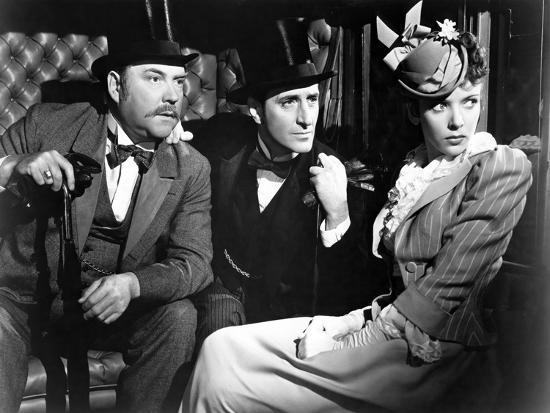
In 1910, Doyle wrote another highly successful stage version of a Sherlock Holmes tale, “The Speckled Band”. H.A. Saintsbury took the role of Holmes this time, to great acclaim, but Doyle’s attention was elsewhere.
He recorded in his memoirs: “We had a fine rock boa to play the title-role, a snake which was the pride of my heart….We had several snakes at different times, but they were none of them born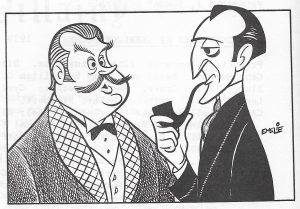 actors and they were all inclined either to hang down from the hole in the wall like inanimate bell-pulls, or else to turn back through the hole and get even with the stage carpenter who pinched their tails to make them more lively.”
actors and they were all inclined either to hang down from the hole in the wall like inanimate bell-pulls, or else to turn back through the hole and get even with the stage carpenter who pinched their tails to make them more lively.”
Fortunately, the snakes were not poisonous and none of the stage carpenters seems to have met the fate of Dr. Grimesby Roylott!
The success of Doyle’s plays sparked a flood of unauthorized Holmes plays, as well as burlesques (one entitled “Sheerluck Jones”). Holmes has remained a staple on the stage throughout the twentieth century. The 1960’s saw a musical comedy based on the tales–“Baker Street”–and the 1970’s brought a revival of the William Gillette play with John Neville as Holmes in the New York production and John Wood taking the role in the London production. The choice of John Neville for the part was no doubt prompted by memories of his brilliant performance in our second film this afternoon, A Study in Terror.
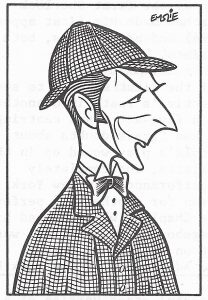 Turning from stage to screen, we find the earliest Holmes films making their appearance about 1906. They spread rapidly throughout Europe and in 1912, the film rights to the tales were sold in the Eclair Company of France, who made nine films based on Doyle’s stories. 1916 saw a film version of the William Gillette play, starring Gillette himself. Ellie Norwood played Holmes in 47 films made for the Stoll Film Company of Great Britain and was highly praised by Doyle himself for his interpretation of the role. Doyle wrote: “He has that rare quality which can only be described as glamour, which compels you to watch an actor eagerly when he is doing nothing. He has the brooding eye which excites expectation and he has also a quite unrivalled power of disguise.”
Turning from stage to screen, we find the earliest Holmes films making their appearance about 1906. They spread rapidly throughout Europe and in 1912, the film rights to the tales were sold in the Eclair Company of France, who made nine films based on Doyle’s stories. 1916 saw a film version of the William Gillette play, starring Gillette himself. Ellie Norwood played Holmes in 47 films made for the Stoll Film Company of Great Britain and was highly praised by Doyle himself for his interpretation of the role. Doyle wrote: “He has that rare quality which can only be described as glamour, which compels you to watch an actor eagerly when he is doing nothing. He has the brooding eye which excites expectation and he has also a quite unrivalled power of disguise.”
Nor did interest in Holmes diminish with the coming of the talkies. Clive Brook, Raymond Massey, Robert Rendell and Reginald Owen all appeared in the role on screen. Reginald Owen has in fact the dubious distinction of being the only man ever to play both Holmes and Watson!
Among those whose essayed the role more than once or twice, Arthur Wontner stood out for a long time as the best. He began playing Holmes in 1931 and his portrayal was widely regarded as definitive until the arrival of Basil Rathbone in the role in 1939. Wontner soon abandoned the role and was to be seen in occasional character roles throughout the 40’s.
The Adventures of Sherlock Holmes was the second of 14 Holmes films Basil Rathbone would star in. British born, Rathbone began his career as a Shakespearean stage actor, entering films in the 20’s as a romantic lead. The coming of sound and the discovery of his distinctive voice launched his career as a villain, before he became a detector of villainy as Sherlock Holmes. The ease with which he moved between the two opposing roles suggests the link that always exists in Doyle’s stories between Holmes and the master criminal Moriarty he pursues.
Nigel Bruce consistently played Dr. Watson to Basil Rathbone’s Holmes. The son of a baronet, Bruce specialized in convincing, often bumbling, upper-class characters or Colonel Blimp types on British and American stages and screens for decades.
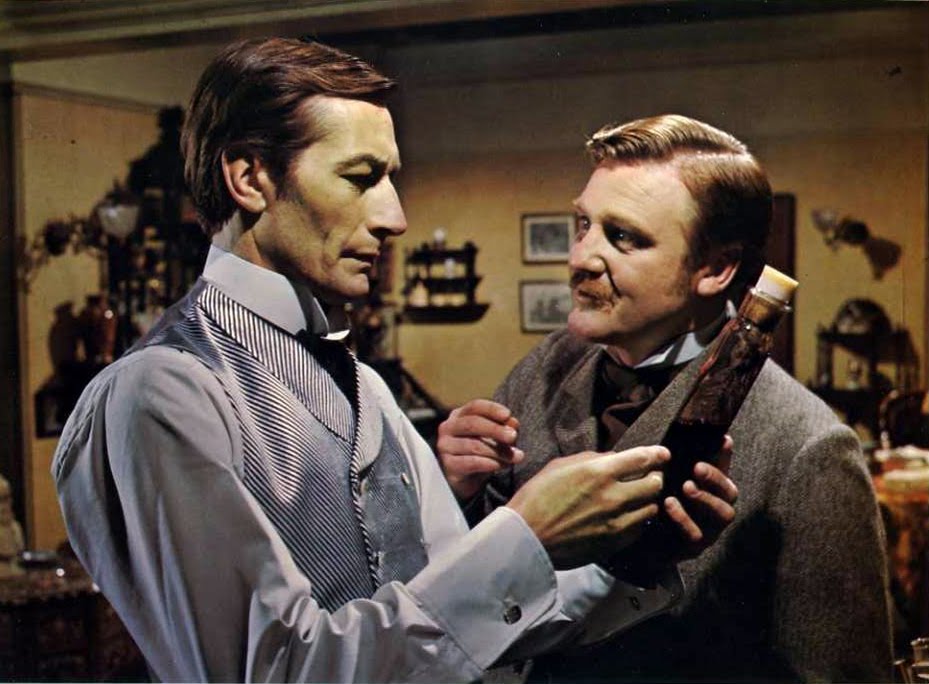
George Zucco takes the role of Prof. Moriarty, by no means an alien one to him, for he forged his career from his portrayals of master criminals, mad scientists and the like. (It is interesting to note that, although he too was British born, he made his acting debut in Canada.) In The Adventures of Sherlock Holmes, however, Moriarty is not out to commit murder and mayhem or subvert the civilized world. Instead, he only wants to steal the crown jewels and he is even sporting enough to give Scotland Yard warning of his intentions! The frivolous nature of Moriarty’s enterprise lends a note of lightheartedness to the film conspicuously lacking in our second film of the afternoon, A Study in Terror.
The villain in A Study in Terror is Jack the Ripper and thus Doyle’s cool logician gets to pit his deductive skills against the most famous depraved mind of Victorian London. John Neville takes the part of Holmes. Neville is currently appearing as Prof. Henry Higgins in the Stratford Festival production of “My Fair Lady”. He is backed up by a sterling cast. TFS members will have to decide if his performance can top that of Jeremy Brett on the recent television series, the latest in a seemingly endless string of Holmes!
Notes by Laurie McNeice
Sketches by Peter Emslie



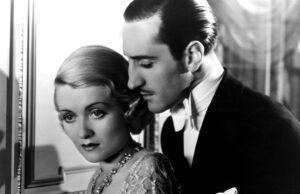






Leave a Reply